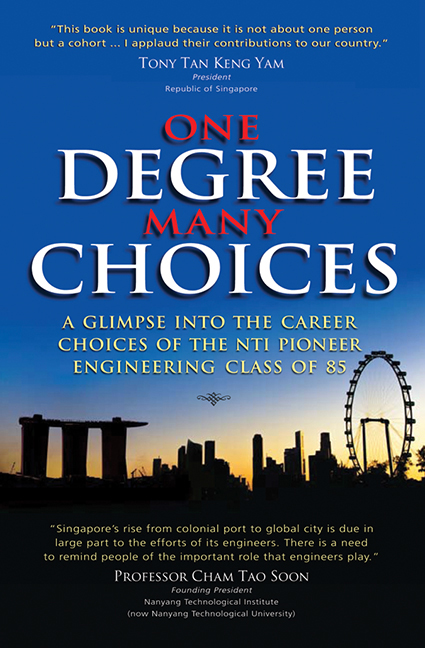 One Degree, Many Choices
One Degree, Many Choices Book contents
- Frontmatter
- Contents
- WHAT THIS BOOK IS ABOUT
- FOREWORD
- ACKNOWLEDGEMENTS
- INTRODUCTION It's All About Life Choices
- PART I THE BEGINING
- PART II ENGINEERING PURSUITS
- CHAPTER 4 Riding High on Semiconductors
- CHAPTER 5 Thriving in the Chemical Industry
- CHAPTER 6 Navigating the Marine Industry
- CHAPTER 7 Rise & Decline of the Disk Drive Industry
- CHAPTER 8 Boom & Bust in the Electronics Industry
- CHAPTER 9 Leading Lights in the IT Industry
- CHAPTER 10 Riding the Ups & Downs in the Telecommunications Industry
- CHAPTER 11 Transporting the Masses
- CHAPTER 12 Providing Electricity & Gas to Singaporeans
- CHAPTER 13 Environment Engineering & Inventions
- CHAPTER 14 Building Infrastructure & Housing Millions
- CHAPTER 15 Building Jewels In & Out of Singapore
- CHAPTER 16 Soaring in Aerospace
- CHAPTER 17 Banking on the Emerging Life Sciences Industry
- CHAPTER 18 Making Waves in Other Industries
- CHAPTER 19 Growing Singapore Inc through Government-Linked Companies
- CHAPTER 20 Defending Our Nation
- CHAPTER 21 Moulding Future Leaders
- CHAPTER 22 Training Engineers at the Frontline
- CHAPTER 23 The CSE Entrepreneurs
- CHAPTER 24 Technopreneurs from EEE
- CHAPTER 25 MPE Graduates Who Became Their Own Boss
- PART III THE LADY ENGINEERS
- PART IV NON-ENGINEERING PURSUITS
- PART V EPILOGUE
- APPENDICES
- THE SUPPORT TEAM
CHAPTER 4 - Riding High on Semiconductors
from PART II - ENGINEERING PURSUITS
Published online by Cambridge University Press: 21 October 2015
- Frontmatter
- Contents
- WHAT THIS BOOK IS ABOUT
- FOREWORD
- ACKNOWLEDGEMENTS
- INTRODUCTION It's All About Life Choices
- PART I THE BEGINING
- PART II ENGINEERING PURSUITS
- CHAPTER 4 Riding High on Semiconductors
- CHAPTER 5 Thriving in the Chemical Industry
- CHAPTER 6 Navigating the Marine Industry
- CHAPTER 7 Rise & Decline of the Disk Drive Industry
- CHAPTER 8 Boom & Bust in the Electronics Industry
- CHAPTER 9 Leading Lights in the IT Industry
- CHAPTER 10 Riding the Ups & Downs in the Telecommunications Industry
- CHAPTER 11 Transporting the Masses
- CHAPTER 12 Providing Electricity & Gas to Singaporeans
- CHAPTER 13 Environment Engineering & Inventions
- CHAPTER 14 Building Infrastructure & Housing Millions
- CHAPTER 15 Building Jewels In & Out of Singapore
- CHAPTER 16 Soaring in Aerospace
- CHAPTER 17 Banking on the Emerging Life Sciences Industry
- CHAPTER 18 Making Waves in Other Industries
- CHAPTER 19 Growing Singapore Inc through Government-Linked Companies
- CHAPTER 20 Defending Our Nation
- CHAPTER 21 Moulding Future Leaders
- CHAPTER 22 Training Engineers at the Frontline
- CHAPTER 23 The CSE Entrepreneurs
- CHAPTER 24 Technopreneurs from EEE
- CHAPTER 25 MPE Graduates Who Became Their Own Boss
- PART III THE LADY ENGINEERS
- PART IV NON-ENGINEERING PURSUITS
- PART V EPILOGUE
- APPENDICES
- THE SUPPORT TEAM
Summary
“What I learned at NTI was relevant and of international standard.”
— Chua Thian Yee, EEE PioneerWATCHING THE CLOSURE of National Semiconductor's Singapore plant in 2006 was memorable for Gary Chan. “It was an invaluable experience as one of the last few men standing,” said Gary who was involved in the shut-down process from start to end. He had been with the company after it acquired his first employer Fairchild Semiconductor in 1987. National Semiconductor was a job lifeline to grateful NTI pioneers such as Ooi Kok Chan. He shared, “I did my industrial attachment at National Semiconductor and they offered me the post of a test engineer one month after graduation.”
Fairchild Semiconductor, an American firm, employed many NTI pioneers including Liu Fook Thim. In 1985, American semiconductor companies were trying to catch up with their Japanese competitors. The Japanese excelled in statistical process control techniques. “I was hired to implement this technique at Fairchild,” said Fook Thim who studied the subject at NTI. However, it was a challenge to get cooperation from production and maintenance staff. Things changed only after the top issued a directive.
Many NTI pioneers started their careers in this industry, a stepping stone for some NTI pioneers to greater things. R. Sinnakaruppan and Inderjit Singh were working for National Semiconductors and Texas Instrument respectively before entering politics.
The semiconductor industry is an important component of Singapore's economy. All parts of the semiconductor value chain including research and development and manufacturing are here. In 2008, semiconductors formed 55 per cent of the country's total electronics manufacturing output of $68 billion. That was 11 per cent of the global semiconductor output.
In 1969, Singapore welcomed the first chip assembly and test plant set up by National Semiconductor. In the 1980s, other Silicon Valley semiconductor companies such as General Electric Intersil came and turned Singapore into a semiconductor packaging powerhouse. Charlie Foo Siang Sin spent the early part of his career with Intersil before moving to do electronics packaging at 3M's Woodlands factory. It produces flexible circuits used in mobile phones, disk drives and ink-jet printers.
- Type
- Chapter
- Information
- One Degree, Many ChoicesA Glimpse into the Career Choices of the NTI Pioneer Engineering Class of 85, pp. 23 - 26Publisher: ISEAS–Yusof Ishak InstitutePrint publication year: 2012
